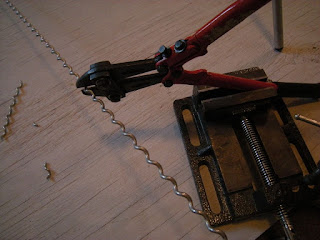| This 2-ply, unwound from a 3x2 compound helix, exhibits a 3:1 frequency ratio. |
Friday, June 30, 2017
Counting frequency ratio in a compound helix
The easiest way to count the frequency ratio in a compound helix is to count (starting from zero) the outward appearances of a single sub-strand in full major helix wavelength, and then subtract one for the counter-rotation effect of following the major helix.
Pitch angle = pitch angle
In ordinary-lay compound helices, a stable configuration tends to occur when the pitch angle of the major helix equals the pitch angle of the minor helices. For example, the case below of a 3x3 compound helix: the 70 degree pitch angle (measured from the equatorial plane) of the major helix matches that of the three 3-ply strands. The frequency ratio in the 3x3 compound helix is 2:1. The equality of pitch angles together with the counter-rotation of the ordinary lay, make exposed strands look like they run straight along the rope.
| 3-ply strands with 70-degree pitch. |
Compound 3x3 helix with 70-degree pitch.
Thursday, June 29, 2017
First attempt at 3x2 Z's in 12 gauge steel
These were formed from dull galvanized 12 gauge steel wire pretwisted to about a 60 degree angle (too much it proved). Some surface fracturing in the final shape, not elastic enough, and very hard to work by hand.
Possible non A-Trail vertices for Twongs and Z's
In the simplest, most versatile versatile vertex for Twongs and Z's, each element twines with its immediate clockwise neighbor, as in this three-talent vertex:
But there are other possibilities that may be useful:
But there are other possibilities that may be useful:
Twongs flashback (bending)
Continuing the forming details for the 9-gauge 2-ply 'Twongs' presented at 2010 New York Maker Faire:
| Schematic for bending |
| Bending jig in use |
 |
| Completed bend |
 |
| Completed Twongs |
 |
| Twongs ready for the Faire |
Twongs flashback (cont.)
Continuing the forming details for 'Twongs' 2-ply helices presented at 2010 New York Maker Faire:
Twongs Flashback
I presented a 2x1 helical wire construction set called Twongs at the 2010 New York Maker Faire.
 |
| Four twongs formed from 9 gauge galvanized steel wire |
 |
| Untwining the 2-ply in the forming step |
 |
| Partially completed twong vertex |
 |
| Completed twong vertex |
| As purchased wire |
| Wire being partially straightened winding "the other way" against a 18.5" radius template |
| Winding end of manual twiner |
 |
| Sledge end of twiner |
| Man at work |
Wednesday, June 28, 2017
3x2 strand construction for wire Z's
| 3x2 strand construction. All three strands have one white and one orange fiber. |
| The strands have 3 times the twist frequency of the super helix. |
Below is a 3x2 construction realized in 24 gauge galvanized steel wire by twisting with a reversible drill. Tension was about 20lbs (dragging an anvil on a rug along a tile floor).
| 3x2 coiled coil construction in 24 gauge galvanized steel wire |
| Unwinding the 24 gauge steel coiled coil shows that the frequency ratio is 3:1 |
| Unwinding the compound helix shows some irregularities. |
| A sloppy tetrahedron from 3x2 compound helices of 24 gauge galvanized wire. |
Tuesday, June 27, 2017
Metal Z's from compound helical arrangements
 |
| A 3-ply of 3-plies. In each turn of the superhelix, each component 3-ply completes two turns. Ordinary rope lay is used: the superhelix has twist opposite to that of the three component plies. |
An alternative for metal Z's is to use wire rope in place of the solid strands. The configuration above naturally locks together when the superhelix is twisted oppositely to the three 3-ply components.
Another possibility is a 3-ply of 2-plies, also ordinary lay.
| A 3-ply of 2-plies. Components complete 2 turns in one turn of superhelix. |
Monday, June 26, 2017
Z-bent Springs poster at SMI 2017
I presented a poster last week at Shape Modeling International 2017 in Berkeley, CA summarizing the technique of assembling wireframe meshes from triple helices. The presentation included a hands-on exhibit of Z's made from 1.75 mm ABS filament.
Tuesday, June 20, 2017
DNA inspired baskets: Weaving Z- bent springs
The sculpture also reveals a mechanical weakness in using DNA in this scheme: strand exchange using double helices leaves a single-stranded section in the center of each strut where the splices are made.
Since, unlike DNA, at macro scale we are not limited to double helices, we can move up to triple helices. Triple helices can be joined with have a triple-stranded middle sections (see the octahedron in the top image) and splices near the ends of the strut where they cause less trouble mechanically.
Z-shaped segments can be used to make any mesh since every
edge has a unique clockwise neighbor at each end--automatically
giving a triple cover of each edge.
Subscribe to:
Posts (Atom)








